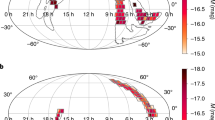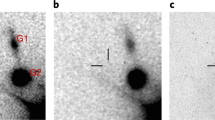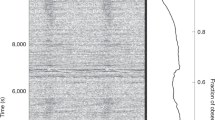Abstract
The merger of two dense stellar remnants including at least one neutron star is predicted to produce gravitational waves (GWs) and short-duration gamma ray bursts1,2. In the process, neutron-rich material is ejected from the system and heavy elements are synthesized by r-process nucleosynthesis1,3. The radioactive decay of these heavy elements produces additional transient radiation termed kilonova or macronova4,5,6,7,8,9,10. We report the detection of linear optical polarization, P = (0.50 ± 0.07)%, 1.46 days after detection of the GWs from GW 170817—a double neutron star merger associated with an optical macronova counterpart and a short gamma ray burst11,12,13,14. The optical emission from a macronova is expected to be characterized by a blue, rapidly decaying component and a red, more slowly evolving component due to material rich in heavy elements—the lanthanides15. The polarization measurement was made when the macronova was still in its blue phase, during which there was an important contribution from a lanthanide-free outflow. The low degree of polarization is consistent with intrinsically unpolarized emission scattered by galactic dust, suggesting a symmetric geometry of the emitting region and low inclination of the merger system. Stringent upper limits to the polarization degree from 2.45–9.48 days post-burst are consistent with the lanthanides-rich macronova interpretation.
This is a preview of subscription content, access via your institution
Access options
Access Nature and 54 other Nature Portfolio journals
Get Nature+, our best-value online-access subscription
$29.99 / 30 days
cancel any time
Subscribe to this journal
Receive 12 digital issues and online access to articles
$119.00 per year
only $9.92 per issue
Buy this article
- Purchase on Springer Link
- Instant access to full article PDF
Prices may be subject to local taxes which are calculated during checkout

Similar content being viewed by others
Change history
30 October 2017
In the version of this Letter originally published, in the third paragraph of the text Kyutoku et al. were not correctly cited and the sentence should have read: “As pointed out by Kyutoku at al.28, in the case of high optical depth to electron scattering (~1) and assuming spectral lines do not significantly depolarize the global emission, the linear polarization observed from the equatorial plane could be as high as a few per cent.” Also, in the Author contributions section, the final sentence should have read: “C.G.M. contributed to the writing of the paper.”
References
Eichler, D., Livio, M., Piran, T. & Schramm, D. N. Nucleosynthesis, neutrino bursts and gamma-rays from coalescing neutron stars. Nature 340,126–128 (1989).
Berger, E. Short-duration gamma-ray bursts. Annu. Rev. Astron. Astrophys. 52, 43–105 (2014).
Rosswog, S. et al. Mass ejection in neutron star mergers. Astron. Astrophys. 341, 499–526 (1999).
Li, L.-X. & Paczyński, B. Transient events from neutron star mergers. Astrophys. J. 507, L59–L62 (1998).
Rosswog, S. Mergers of neutron star-black hole binaries with small mass ratios: nucleosynthesis, gamma-ray bursts, and electromagnetic transients. Astrophys. J. 634, 1202–1213 (2005).
Metzger, B. D. et al. Electromagnetic counterparts of compact object mergers powered by the radioactive decay of r-process nuclei. Mon. Not. R. Astron. Soc. 406, 2650–2662 (2010).
Kasen, D., Badnell, N. R. & Barnes, J. Opacities and spectra of the r-process ejecta from neutron star mergers. Astrophys. J. 774, 25 (2013).
Barnes, J. & Kasen, D. Effect of a high opacity on the light curves of radioactively powered transients from compact object mergers. Astrophys. J. 775, 18 (2013).
Tanaka, M. & Hotokezaka, K. Radiative transfer simulations of neutron star merger ejecta. Astrophys. J. 775, 113 (2013).
Baiotti, L. & Rezzolla, L. Binary neutron star mergers: a review of Einstein’s richest laboratory. Rep. Prog. Phys. 80, 096901 (2017).
Abbott, B. P. et al. (LIGO Scientific Collaboration and Virgo Collaboration) GW170817: Observation of gravitational waves from a binary neutron star inspiral. Phys. Rev. Lett. https://doi.org/10.1103/PhysRevLett.119.161101 (2017).
Savchenko, V. et al. INTEGRAL detection of the first prompt gamma-ray signal coincident with the gravitational event GW170817. Astrophys. J. Lett. https://doi.org/10.3847/2041-8213/aa8f94 (2017).
Goldstein et al. An ordinary short gamma-ray burst with extraordinary implications: Fermi-GBM detection of GRB 170817A. Astrophys. J. Lett. https://doi.org/10.3847/2041-8213/aa8f41 (2017).
Coulter, D. et al. Swope Supernova Survey 2017a (SSS17a), the optical counterpart to a gravitational wave source. Science https://doi.org/10.1126/science.aap9811 (2017).
Kasen, D., Fernàndez, R. & Metzger, B. D. Kilonova light curves from the disc wind outflows of compact object mergers. Mon. Not. R. Astron. Soc. 450, 1777–1786 (2015).
Pian, E. et al. Spectroscopic identification of r-process nucleosynthesis in a double neutron star merger. Nature https://doi.org/10.1038/nature24298 (2017).
Tanvir, N. R. et al. A 'kilonova' associated with the short-duration γ-ray burst GRB 130603B. Nature 500, 547–549 (2013).
Yang, B. et al. A possible macronova in the late afterglow of the ‘long-short’ burst GRB 060614. Nat. Commun. 6, 7323 (2015).
Jin, Z.-P. et al. The light curve of the macronova associated with the long-short burst GRB 060614. Astrophys. J. 811, L22 (2015).
Jin, Z.-P. et al. The macronova in GRB 050709 and the GRB–macronova connection. Nat. Commun. 7, 12898 (2016).
Ghirlanda, G. et al. Short gamma-ray bursts at the dawn of the gravitational wave era. Astron. Astrophys. 594, A84 (2016).
Jin, Z.-P. et al. Short GRBs with small opening angles: implications on local neutron star merger rate and GRB/GW association. Preprint athttps://arxiv.org/abs/1708.07008 (2017).
Mundell, C. G. et al. Highly polarized light from stable ordered magnetic fields in GRB 120308A. Nature 504, 119–121 (2013).
Wiersema, K. et al. Circular polarization in the optical afterglow of GRB 121024A. Nature 509, 201–204 (2014).
Goriely, S., Bauswein, A. & Janka, H.-T. r-process nucleosynthesis in dynamically ejected matter of neutron star mergers. Astrophys. J. 738, L32 (2011).
Hotokezaka, K. et al. Remnant massive neutron stars of binary neutron star mergers: evolution process and gravitational waveform. Phys. Rev. D 88, 044026 (2013).
Kiuchi, K., Cerdà-Duràn, P., Kyutoku, K., Sekiguchi, Y. & Shibata, M. Efficient magnetic- field amplification due to the Kelvin–Helmholtz instability in binary neutron star mergers. Phys. Rev. D 92, 124034 (2015).
Kyutoku, K., Ioka, K., Okawa, H., Shibata, M. & Taniguchi, K. Dynamical mass ejection from black hole-neutron star binaries. Phys. Rev. D 92, 044028 (2015).
Tanaka, M. et al. Radioactively powered emission from black hole-neutron star mergers. Astrophys. J. 780, 31 (2014).
Granot, J., Panaitescu, A., Kumar, P. & Woosley, S. E. Off-axis afterglow emission from jetted gamma-ray bursts. Astrophys. J. 570, L61–L64 (2002).
Aasi, J. et al. Characterization of the LIGO detectors during their sixth science run. Classical and Quantum Gravity 32, 074001 (2015).
Acernese, F. et al. Advanced Virgo: a second-generation interferometric gravitational wave detector. Class. Quantum Grav. 32, 024001 (2015).
Serkowski, K., Mathewson, D. S. & Ford, V. L. Wavelength dependence of interstellar polarization and ratio of total to selective extinction. Astrophys. J. 196, 261–290 (1975).
Plaszczynski, S., Montier, L., Levrier, F. & Tristram, M. A novel estimator of the polarization amplitude from normally distributed Stokes parameters. Mon. Not. R. Astron. Soc. 439, 4048–4056 (2014).
Wiersema, K. et al. Detailed optical and near-infrared polarimetry, spectroscopy and broad-band photometry of the afterglow of GRB 091018: polarization evolution. Mon. Not. R. Astron. Soc. 426, 2–22 (2012).
Acknowledgements
This study was based on observations collected at the European Organisation for Astronomical Research in the Southern Hemisphere under European Southern Observatory programme 099.D-0116. We thank the European Southern Observatory—Paranal staff for carrying out excellent observations under difficult conditions during a hectic period. We also acknowledge partial funding from Agenzia Spaziale Italiana-Istituto Nazionale di Astrofisica grant I/004/11/3. K.W., A.B.H., R.L.C.S. and N.R.T. acknowledge funding from the Science and Technology Facilities Council. J.H. was supported by a VILLUM FONDEN Investigator grant (project number 16599). Y.Z.F. was supported by the National Natural Science Foundation of China under grant 11525313. C.G.M. acknowledges support from the UK Science and Technology Facilities Council. K.T. was supported by Japan Society for the Promotion of Science grant 15H05437 and a Japan Science and Technology Consortia grant. J.M. acknowledges the National Natural Science Foundation of China 11673062 and the Major Program of the Chinese Academy of Sciences(KJZD-EW-M06).
Author information
Authors and Affiliations
Contributions
All authors contributed to the work presented in this paper. S.C. and K.W. coordinated the data acquisition, analysed the data and wrote the paper. A.B.H., A.M., P.D., E.P. and N.T. contributed to the data analysis. Y.F. and K.T. contributed to the theoretical discussion. C.G.M. contributed to the writing of the paper.
Corresponding author
Ethics declarations
Competing interests
The authors declare no competing financial interests.
Additional information
Publisher’s note: Springer Nature remains neutral with regard to jurisdictional claims in published maps and institutional affiliations.
A correction to this article is available online at https://doi.org/10.1038/s41550-017-0319-6.
Rights and permissions
About this article
Cite this article
Covino, S., Wiersema, K., Fan, Y.Z. et al. The unpolarized macronova associated with the gravitational wave event GW 170817. Nat Astron 1, 791–794 (2017). https://doi.org/10.1038/s41550-017-0285-z
Received:
Accepted:
Published:
Issue Date:
DOI: https://doi.org/10.1038/s41550-017-0285-z
This article is cited by
-
Spherical symmetry in the kilonova AT2017gfo/GW170817
Nature (2023)
-
Electromagnetic counterparts of gravitational wave sources at the Very Large Telescope
Nature Reviews Physics (2020)
-
Kilonovae
Living Reviews in Relativity (2020)
-
Rotational disruption of dust grains by radiative torques in strong radiation fields
Nature Astronomy (2019)
-
Discovery of a kilonova and prospects for future hunts
Rendiconti Lincei. Scienze Fisiche e Naturali (2019)



